Sandro Botticelli, Primavera
Like most artists in the second half of the fifteenth century, Sandro Botticelli (1445-1510) learned to draw and paint sculptural figures that were modeled by light from a consistent source and placed in a setting rendered illusionistic by linear perspective. Like other artists working or patrons steeped in Classical scholarship and humanistic thought, he was exposed to philosophical speculations on beauty – as well as to the examples and ancient art in his employer’s collections. For the Medici, Botticelli produced secular paintings of mythological subjects inspired by ancient works and by contemporary Neoplatonic thought.

The overall appearance of Botticelli’s Primavera, or Spring, recalls Flemish tapestries, which were very popular in Italy at the time. And its subject – like the subjects of many tapestries – is a highly complex allegory (a symbolic illustration of a concept or principle), interweaving Neoplatonic ideas with esoteric references to Classical sources. In simple terms, Neoplatonic philosophers and poets conceived Venus, the goddess of love, as having two natures. The first ruled over earthly, human love and the second over universal, divine love. In this way, the philosophers could argue that Venus was a Classical equivalent of the Virgin Mary. Primavera was painted at the time of the wedding of Lorenzo di Pierfrancesco de’ Medici and Semiramide d’Appiano in 1482. The theme suggests love and fertility in marriage, and the painting can be read as a lyrical wish for a similar fecundity in the union of Lorenzo and Semiramide – a sort of highly refined fertility dance.
The setting of the painting is a grove of orange trees. These hold a double meaning – both suggestive of Venus’s Garden of the Hesperides, with its golden fruit, and perhaps an allusion to the Medici, whose coat of arms featured golden orbs.
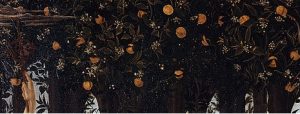
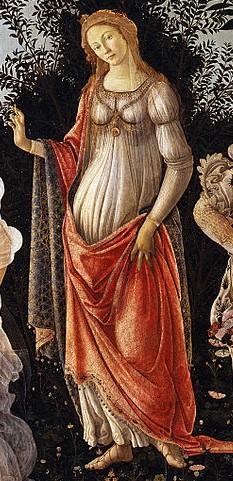
Venus, clothed in contemporary costume and crowned with a marriage wreath, appears in her role as the goddess of wedded love.
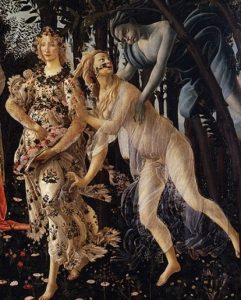
This three-figure grouping tells a story. Zephyrus, the west wind, is accosting the virgin nymph Chloris, identifiable from the roses pouring out of her mouth. Once Zephyrus makes her his bride, Chloris is transformed into the goddess Flora, the elaborately dressed personification of spring at the front of the group.
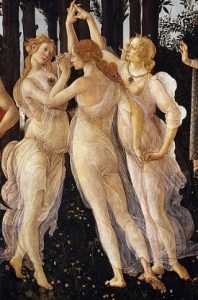
The three graces symbolize ideal female virtues – Chastity, Beauty, Love. Venus’ son Cupid – the embodiment of romantic desire – playfully aims his arrow at them.
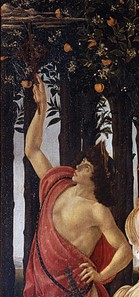
Mercury, the sign for the month of May, disperses the winter clouds with his caduceus. This staff wound with serpents became a symbol for the medical profession. The name Medici means “doctors.”
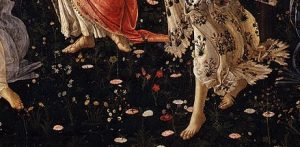
So accurate is their representation, 138 of the 190 flowering plants depicted in the painting have been identified. Almost all grow in the neighborhood of Florence between the months of March and April, and most carry symbolic associations with love and marriage.[1]
- Marilyn Stokstad, Art History, vol. 2, 4th ed, (Upper Saddle River, NJ: Prentice Hall: 2011), 626. ↵

